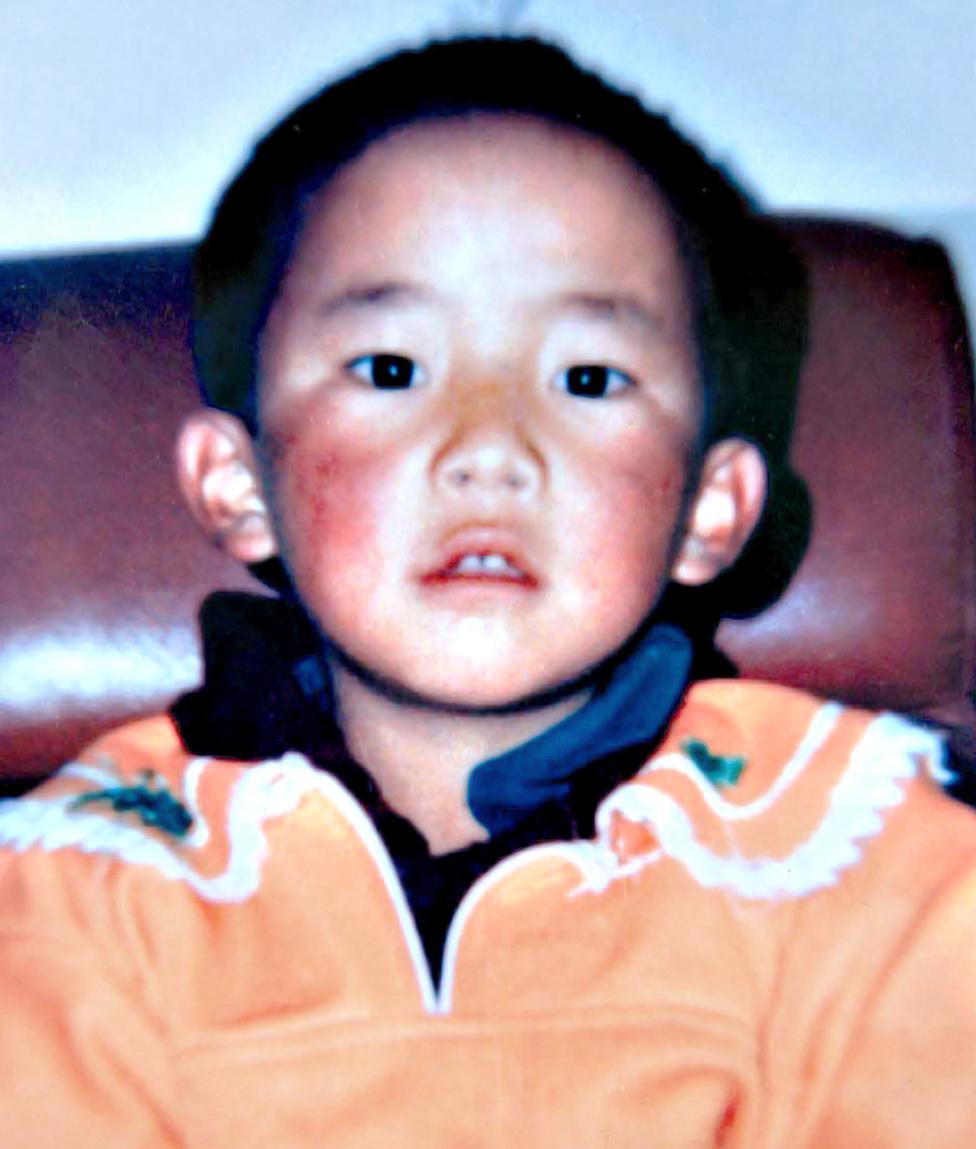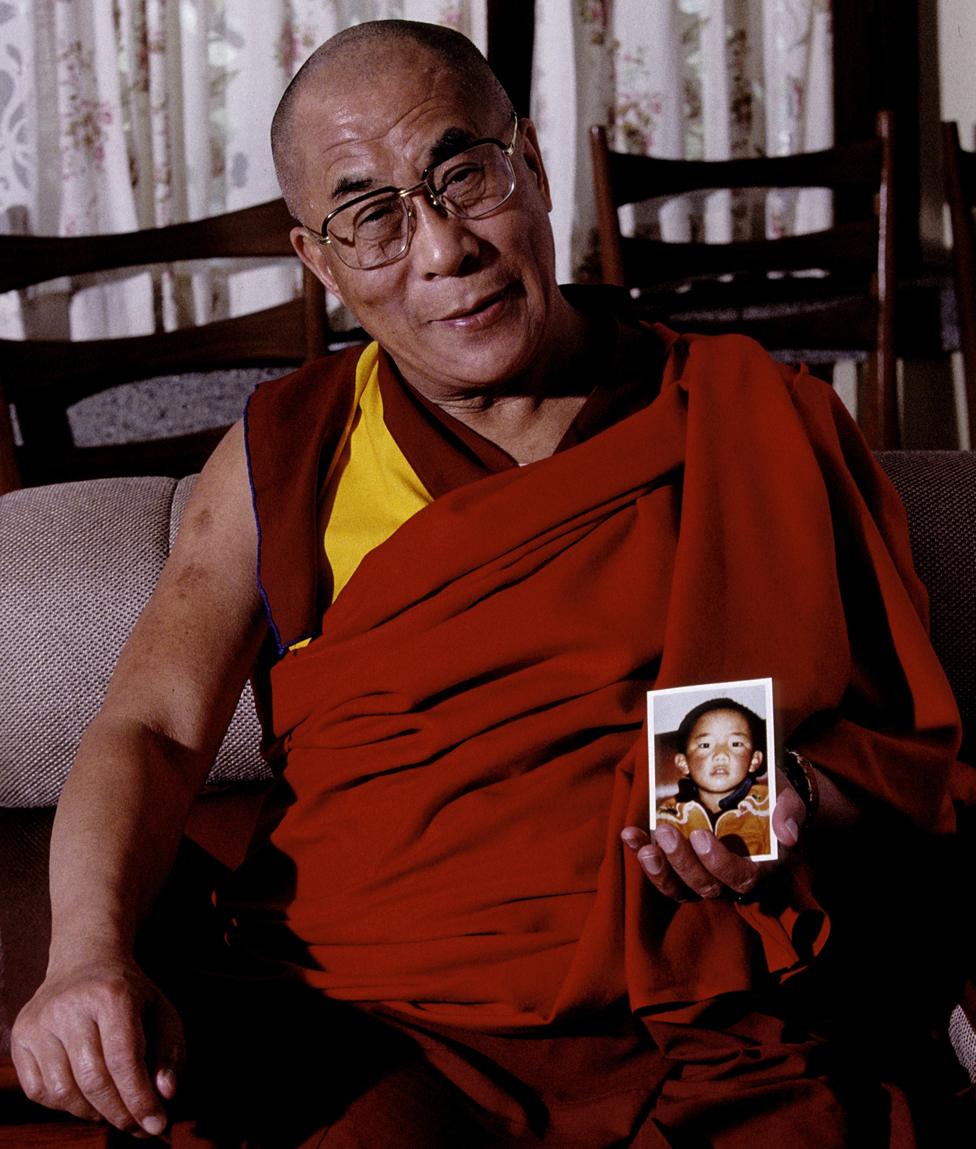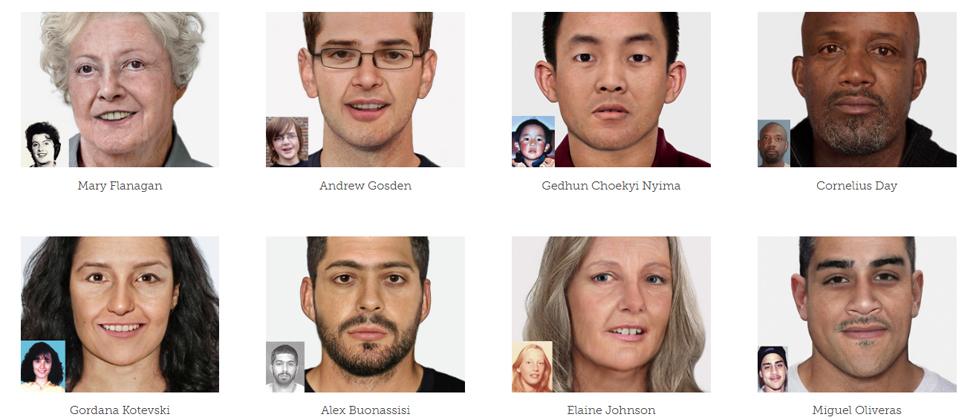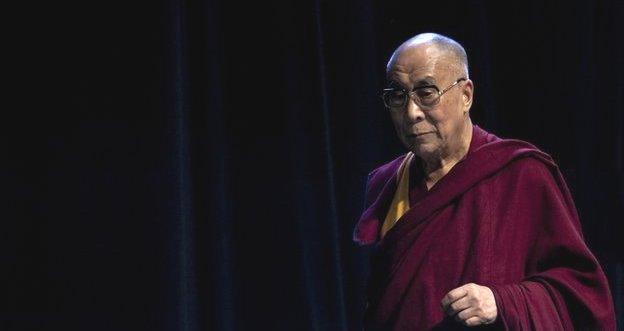Is this the face of a man held captive since the age of six?
- Published

The second most important figure in Tibetan Buddhism was termed the world's youngest political prisoner after he was taken captive by the Chinese authorities in 1995 at the age of six. Twenty-four years later, he's still nowhere to be seen - which poses a tricky question about the future of the faith.
Why was he taken captive?
Tibetan Buddhists believe in reincarnation. When the second most important Tibetan Buddhist leader, the Panchen Lama, died in suspicious circumstances in 1989 (some believe he may have been poisoned by the Chinese government) it was only a matter of time before he would be reincarnated.
On 14 May 1995 the head of the Tibetan Buddhist faith, the Dalai Lama, announced that he had been identified - the reincarnation of the Panchen Lama was six-year-old Gedhun Choekyi Nyima, the son of a doctor and a nurse from the Tibetan town of Naqchu.
The Chinese authorities had been hoping that the Panchen Lama would be identified without the involvement of the Dalai Lama, who had left Tibet in 1959 and set up a Tibetan government in exile in northern India. So they removed Gedhun Choekyi Nyima and his family from the scene, and arranged for some compliant Buddhist leaders to select another boy as a puppet Panchen Lama.
What happened next?
He has been kept out of the public eye since he was seized on 17 May 1995. An official once told the South China Morning Post he was living in Gansu, in northern China. Another theory is that he is being held in or near Beijing.
In October 2000, British Foreign Secretary Robin Cook told the House of Commons Foreign Affairs Select Committee, external: "Every time we raise the question of Gedhun Choekyi Nyima... we have received assurances from the government of China that he is in good health and well cared for and that his parents do not wish international intervention.
"At the last meeting last week they produced two photographs of what we were informed was Gedhun Choekyi Nyima, showing him at home. We have not received what is the focus of our demands, which is access to verify this for ourselves."
The boy - who would have been 11 in 2000 - was seen in one picture playing table tennis. The second picture showed the back of his head, as he wrote Chinese characters on a blackboard. But while the photographs were shown to British officials, they were not handed over.
Where does the latest picture come from?
The picture at the top of this page is an age-progression image produced by forensic artist Tim Widden, based on the only known photograph of Gedhun Choekyi Nyima, taken by the search party that scoured Tibet for the reincarnation of the Panchen Lama in 1994-95.


Commissioned to produce the image for the Panchen Lama's 30th birthday, Widden says he had to assume average health and average weight, though it could easily be that he is emaciated. He also had to guess a hairstyle.
When creating an age-progression image of a missing person, Widden usually has a number of photographs to judge by, and photographs of parents or siblings, but in this case there was only one.
Watch how the new age-progression image was made in this report from the One Show
This image was made for the International Tibet Network. A different organisation, the International Campaign for Tibet, published a similar image four years ago, on the 20th anniversary of the Panchen Lama's disappearance, when he would have been 26 years old.


This image shows the Panchen Lama in the robes of a Buddhist monk, but there is no evidence to suggest that he has ever been ordained. When the Chinese authorities have said he is "studying" they have never specified the nature of his studies.
Why is the Panchen Lama so important?
Like the Dalai Lama, the Panchen Lama is considered to be an incarnation of an aspect of Buddha. The Panchen Lama is the reincarnation of Amithaba, the Buddha of Boundless Light, while the Dalai Lama is the reincarnation of Avalokiteshvara (Chenrezig in Tibetan), the Buddha of Compassion.
Traditionally, each acts as mentor to the other, and plays a key role in identifying the other's reincarnation. As the Panchen Lama is more than 50 years younger than the Dalai Lama, he would have been expected, in due course, to recognise the 83-year-old Dalai Lama's successor.


When the Chinese government insisted on controlling the selection of the Panchen Lama in 1995 it may have been preparing for this moment. "They say they are waiting for my death and will recognise a 15th Dalai Lama of their choice," the Dalai Lama wrote in a 2011 message on retirement and reincarnation, external.
Is another Dalai Lama possible without the Panchen Lama?
While the Panchen Lama would usually take a leading role in the search for the Dalai Lama's reincarnation, he is not "the be-all and end-all of the Dalai Lama reincarnation process", says Bhuchung Tsering, vice president of the International Campaign for Tibet.
He anticipates, however, that when the time comes, the Chinese authorities "could use the individual they have selected as Panchen Lama to serve their political interests".
The Dalai Lama told Reuters news agency in March that his successor could be found in India, external, where he and many other Tibetans have lived for the last 60 years.
"In future, in case you see two Dalai Lamas come, one from here, in free country, one chosen by Chinese, then nobody will trust, nobody will respect [the one chosen by China]. So that's an additional problem for the Chinese!" he said.
He also said that a meeting of Tibetan Buddhists in India later this year may discuss whether there is any need for the institution of Dalai Lama to continue.
What is the purpose of publishing a new image?
In a conventional missing persons case, it is always possible that someone will report a sighting. Widden's age-progression images of Andrew Gosden, who went missing as a teenager in 2007, were screened when the English band Muse went on tour this year, in the hope that someone in the audience would have come across him.

In the case of the Panchen Lama, the hope is more that international attention could prompt the Chinese authorities to provide new information.
"Our idea is that we need to reinvigorate this campaign," says Mandie McKeown of the the International Tibet Network.
"There has been no information about what kind of life he is living. There has been no indication what he is studying, and there is conflicting information about where he is."
Given fresh information about the Panchen Lama's whereabouts, campaigners would then press for independent verification, and for him to be allowed to live in freedom, either in Tibet or in exile, McKeown says.
"We will continue to call for release in the strongest way we can."

You may also be interested in:

Four experts consider whether there will be a 15th Dalai Lama.